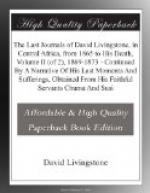It was entirely surrounded by M’toka’s camp, and a constant fight maintained at the point where the line of stakes was weakened by the river running through. He killed four of the enemy, and then Chitimbwa and Kasonso coming to help him, the siege was raised.
M’toka compelled some Malongwana to join him, and plundered many villages; he has been a great scourge. He also seems to have made an attack upon an Arab caravan, plundering it of six bales of cloth and one load of beads, telling them that if they wanted to get their things back they must come and help him conquer Zombe. The siege lasted three months, till the two brothers of Zombe, before-mentioned, came, and then a complete rout ensued. M’toka left nearly all his guns behind him; his allies, the Malongwana, had previously made their escape. It is two months since this rout, so we have been prevented by a kind Providence from coming soon enough. He was impudent and extortionate before, and much more now that he has been emboldened by success in plundering.
16th November, 1872.—After waiting some time for the men I sent men back yesterday to look after the sick donkey, they arrived, but the donkey died this morning. Its death was evidently caused by tsetse bite and bad usage by one of the men, who kept it forty-eight hours without water. The rain, no doubt, helped to a fatal end; it is a great loss to me.
17th November, 1872.—We went on along the bottom of a high ridge that flanks the Lake on the west, and then turned up south-east to a village hung on the edge of a deep chasm in which flows the Aeezy.
18th November, 1872.—We were soon overwhelmed in a pouring rain, and had to climb up the slippery red path which is parallel and near to Mbette’s. One of the men picked up a little girl who had been deserted by her mother. As she was benumbed by cold and wet he carried her; but when I came up he threw her into the grass. I ordered a man to carry her, and we gave her to one of the childless women; she is about four years old, and not at all negro-looking. Our march took us about S.W. to Kampamba’s, the son of Kasonso, who is dead.
19th November, 1872.—I visited Kampamba. He is still as agreeable as he was before when he went with us to Liemba. I gave him two cloths as a present. He has a good-sized village. There are heavy rains now and then every day.
20th, 21st, and 23rd November, 1872.—The men turn to stringing beads for future use, and to all except defaulters I give a present of 2 dotis, and a handful of beads each. I have diminished the loads considerably, which pleases them much. We have now 3-1/2 loads of calico, and 120 bags of beads. Several go idle, but have to do any odd work, such as helping the sick or anything they are ordered to do. I gave the two Nassickers who lost the cow and calf only 1 doti, they were worth 14 dotis. One of our men is behind, sick with dysentery. I am obliged to leave him, but have sent for him twice, and have given him cloth and beads.




